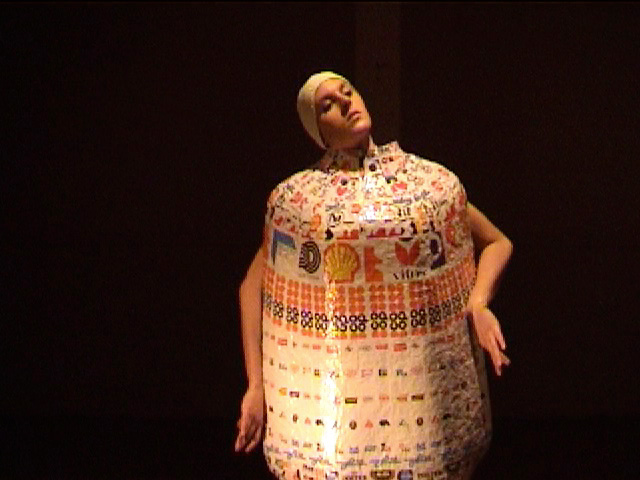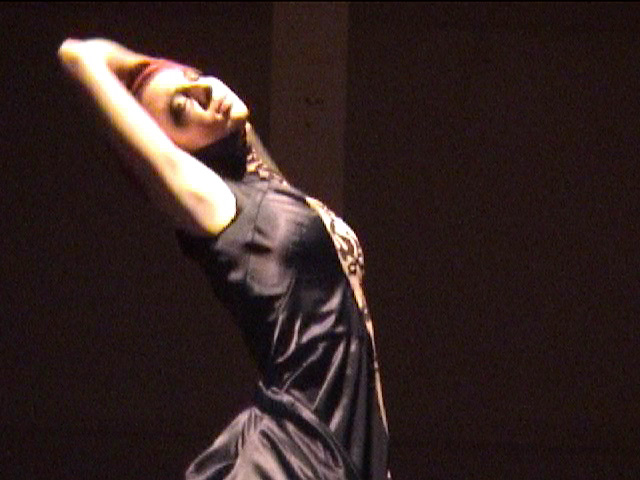Design And Performance Lab
February 14 What we were not able to do last time was to explore the designers' storyboards (Gemma Harrison, Jo Cope) more fully and see how (in the work with physical camera) the action/movement, or characterization that becomes the dress and the character, develops, and how that generates material that can be shaped dramaturgically or choreographically. It can also be a series (animations), changing viewpoints on the person, perhapsin the spirit of a darker portraiture (Yoon Bo's work), or darker video verité passage. Jo, have a look at Essay 1 (online), there's an interesting section on "lived cubism" in video-theatre. The question with more than one performer with a design then is: how to be inter-link the performers, the or their designs, and what they do? The linking of course is the challenge we try to examine in our telematic rehearsals on the “telematic dress.” I want to draw attention to a project I am working on with a dancer who has explored what is called "experiential anatomy" and Skinner release technique. Her movement perceptions are motivated by working with images inside the body, which generally is meant to allow the dancer to open up (internal space_, release, and find more movement and relations to outer movement-space. So there is a phenomenal emphasis (as with Merleau-Ponty and his philosophical emphasis on this doubledness of embodiment, inside-outside, and his writings on visible/invisible bodies) on the inside and the edge, or that porous quality of inside perception and proprioception (all senses being involved when we moved), and how the quick and fully alert body at the same time perceives, senses, and processes the outside world, being in the world. I think our own research-angle now could be, not only the psychic dimensions as they concern Gemma's dress, but also the notion of "unfolding" (in Jo's work) that leads to a spatial dis-order, dissociation, dis-crepancy. I see this also reflected in our use of 3 spaces: inner, outer, and videospace (telematic space), namely the image-space or 3D Virtual Space created through the networking of our video and audio stream. My question to you all (and please, Saeko, you can help us here, describe your dance with the veil): fabric design, spatial design, movement design are space-works, and in our case inclusive of video projection and projective space (a kind of "third space" maybe, inter-mediary between inside and outside). This inter-mediary [[projection] could be a fascinating angle, if we treat videospace as its own digital space yet extending from fabric and being/worn fabric -- that is construed by our inside perception and proprioception in certain ways, but not in equivalence to real 3d physical space. Video after all, is light. With transparent design, the light flows through/across. Why? What happens to the senses that touch or feel or are restricted by the dress? can the projected space shift a perception of dress/design? by wearer, by perceiver/onlooker? how does the onlooker reader psychic dress, the inside ofn dress, the dressness or wearness? Video is image space, and thus cannot quite behave as the physics of 3d space (environment, world), but how then does such space congrue with or converge with our other bodied perceptional rhythms? and how does such rhythm create a particular character (performed), how would you perform such character?
Scheduled Rehearsals:
03-10
The internal more complex opening folds, which
create the transforming part of the dress; Workshop aims; It would also be good to continue to work on
the idea of the three-person interaction. I know after the last workshop Yoonbo expressed an interest in having some input into some of his own shots/compositions to add to the photographic element of the visual experience. So may be it would be good to make time for this in the later part of the first w,shop? So that the filmic part remains focused, and as before their will opportunity to photograph throughout filming.
NOTES FROM ARIZONA AFTER first test rehearsal with the Arziona dress-vessel design (Galina Mihalova):
Congrats on today's event. I think we are onto
something here. Today's event was stimulating and I see much potential
for future development. This Thursday will be a good first step, a chance
to try and sequence some material in time, develop and refine a group
process, and commune with our I would like to throw out some ideas in response to today. Please feel free to respond, correct, refute and/or concur. The idea is of a garment (an antique garment in our case) that is imbued with memory traces, history. These traces include traces of the garment when it was new, when it was handed down, when children played in it, wore it, and so on (perhaps even of those who made it!). Virtual.Physical.Memorial - Performers in different
spaces.continents share a garment through a shared projection stream.
The stream emanates at once This virtual fabric has as its manifestation the garment (empty dress that is all potential) at each site and the "content" shared as a stream between sites, one at NTU and one at ASU. These parts can be composited into a whole, either one on top of the other, or overlayed. The memories, associations, other even more subtle traces rise to the surface...become manifest in movement, interaction, stillness, silence. The garment(s) are animated, brought to life by the images projected upon them. This is the animation from without. The garments can also be animated from within, by the performers. Here the performers react to what they see on the garment(s), or to activities of the other performer. The performers react to each other. Ultimately, (not for this Thursday) they are also interacting with the process of making or combining the images, sound, streams. One idea for sound at ASU is to have a palette
of sounds at the disposal of the performer for Thursday. I didn't have
time to get this together for today, just the humble beginnings. Imagine
Helen, to turn over everything you were doing today with images to the
actions of the performer. This is my Staging suggestions: Perhaps the performers can insinuate themselves
into the garments, creating a transition from the unoccupied to the
occupied. Once fully occupied, the performers can proceed to interact
for a period of perhaps 10 minutes. It might be nice for the performers
to have the opportunity to exchange ideas At the end.....well this is still a toss up. Depending on your world view and disposition...we could end up or down? Thoughts? Preferences? Warmest regards, addendum My things to add are related to sound. Johannes, we liked the idea of combining sounds between sites. Can you plan for this on Thursday? Will Brazil have sound as well? Our sound will be interactive and hopefully at the disposal of the performer in some regards. We have also been discussing spoken text, and I am interested in that. I think the ideal for me would be for the performers to be able to speak, and so for us we keep much of the activity centered on Keira. Best,
I have read all your correspondence/correspondence
from ADAPT partners/Jo etc, sent to me so far, thankyou and am
exploring a number of possibilities for Thursday's event (smpathetically
to others suggestions) I have been extremely busy working on various
prototypes/design possibilities for the 'Telematic Dress.' Interestingly,
the more I have explored ideas (around the sleeve), the more abstracted
my thoughts and 3D piece have become (in terms of process). I have
now managed through the (time consuming) process of construction (of
sleeve), to completely deconstruct the process to bring me to an idea
where designer and performer work together (inspired by fabric and roughly
cut cloth, suggesting partial intervention), to create form/sleeve/telematic
dress. Michèle
03/09 Yes! It would be great to connect with you and the partners on Thursday, March 17. Just confirm the time, so I can set up with the Brazilian Group. That would be sometime between 3 pm and 7 pm New York time, is that right? If you like just 30 mim to connect with you, we need a exact time, so we are warmed up. I personally, and I think my Group share the same feeling, that 30 mim its not enough for a real interactivity on line, but we can connect before the set up time and work on the concepts watching you.
Link very well with the ideas I am exploring in my designs, all three sleeve prototypes are fragments in partial stages of construction/deconstruction and hold memories: The calico sleeve communicates with the past through historically inspired detailing (and later print/hand painted/projected imagery). Then to the future with integrated technology to create an intelligent piece, an idea for further development. The chiffon sleeve speaks of a previous garment form it held (recycled cloth/garment). The wool/silk sleeve, starts from a fine old piece of found cloth, rediscovered and still retaining the memory of a past garment/pattern pieces cut from it... 'It seems to me that we could start with the
dresses alone, devoid of All 3 prototypes (sleeves) could be explored both on and off the body, as fragments waiting to be adorned/acted upon by the body. Johannes, you say in response to my last images sent to you that: '(in terms of how you photographed the hands, with the hands and pieces of accessories on the floor, this could also work really for us in that manner, on the floor or a table, for the interface with the Brasilians.' Yes, I was thinking about this, (having seen the heel and Achilles tendon image) and about focus and intimacy of the image. Also, the 'projected image,' features strongly and I was wondering would it be possible (tomorrow night) to project a flower (oriental Lilly type) onto the calico sleeve and partly onto the body? I was initially going to hand paint the piece, but it would work more in line with others ideas, (Galina and jdm) if the image was projected? Michèle D
|

